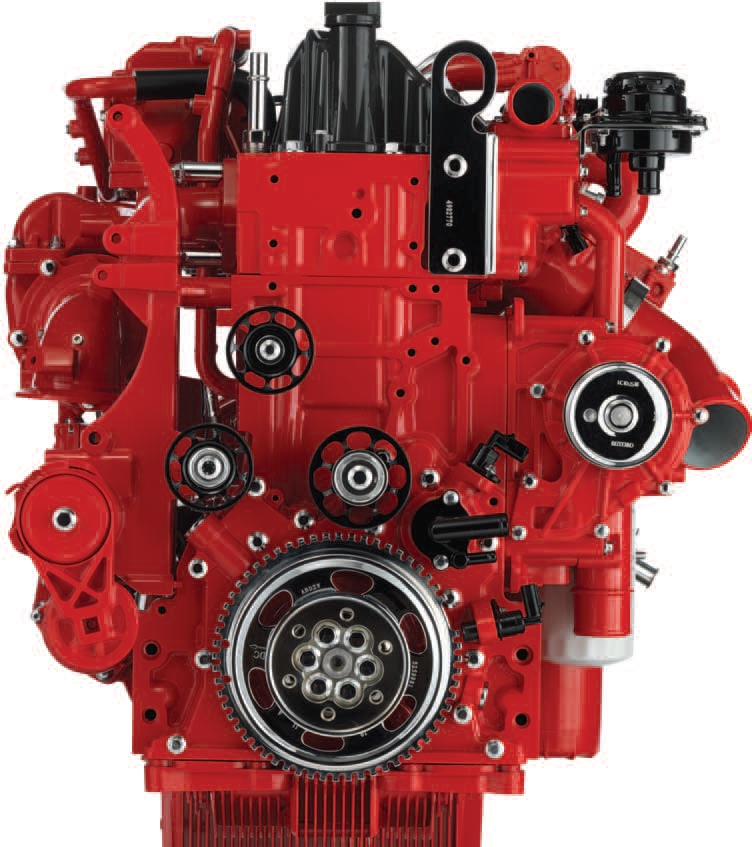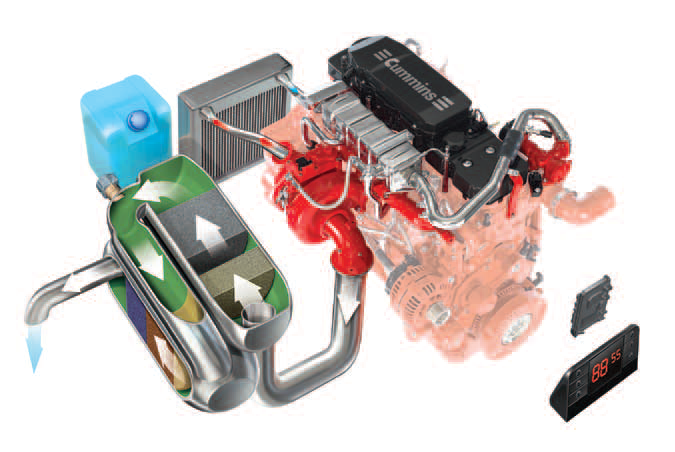 Cummins announced that the latest ISB6.7 engines will be supplied to Scania for use in their Euro 6 buses. Displayed on Cummins stand at Busworld (No.407 in hall 4), the 6-cylinder 6.7 liter ISB engine is available up to 306 ch for a range of ultra-low emission public transport solutions. Peak torque is at a level of 1100 Nm, making it optimal for tough city bus duty cycles.
Cummins announced that the latest ISB6.7 engines will be supplied to Scania for use in their Euro 6 buses. Displayed on Cummins stand at Busworld (No.407 in hall 4), the 6-cylinder 6.7 liter ISB engine is available up to 306 ch for a range of ultra-low emission public transport solutions. Peak torque is at a level of 1100 Nm, making it optimal for tough city bus duty cycles.
Neil Pattison, Director – Automotive Engine Business for Europe, Middle East and Africa, said: “Cummins and Scania have a long standing partnership developing and manufacturing high pressure fuel systems for the latest low emission engines. Our components division has also been supplying turbochargers and filtration components to them for a number of years. This is the first time Scania has specified Cummins engines, and we are delighted to be able to supply our Euro 6 ISB engines for their latest city buses.”
For Euro 6 the ISB6.7 comes with the engine technologies of cooled exhaust gas recirculation (EGR) and variable geometry turbocharging (VGT). The engine technologies are matched to the aftertreatment system, designed and manufactured by Cummins Emission Solutions, combining a Diesel Particulate Filter (DPF) with Selective Catalytic Reduction (SCR) to meet the ultra-low levels of emissions.
“The ISB has built an excellent reputation in bus applications since its introduction for Euro 3. It has become the engine of choice for many vehicle manufacturers in this market based on its durability, performance and efficiency. Backed by our technical support capabilities, we have helped OEMs deliver high-quality installations,” added Pattison.
“For Euro 6, we made our product announcement early to alert the market of our proven technology choice. This has given our customers the confidence to move to Euro 6 with us, and positioned us to win new opportunities like this one with Scania,” he concluded.
ISB6.7 Features
- Electronic Integration – industry standard datalink accepts inputs from all powertrain components including electronic transmissions, ABS brakes and ASR antislip. Creates a seamless flow of information shared along a high speed network.
- Electronic Control Module (ECM) – with increased capability it maintains an optimum balance between load demands, fuel efficiency and emissions. The ECM ensures that the engine and aftertreatment meet the more challenging on-board diagnostics (OBD) monitoring requirements for Euro 6.
- Electronic Protection – sensors throughout the engine continually send data back to the ECM for self-diagnosis and protection. Rapid diagnostics and data downloading are available, helping to ensure maximum uptime for vehicles.
- High Pressure Common Rail fuel system – works at higher pressure and provides more precise control of the combustion process. Capable of generating up to 1800 bar injection pressures for refined and rapid power delivery, reduced noise, and improved cold start.
- Variable Geometry Turbocharger – developed by Cummins Turbo Technologies the VGT is optimized for high torque and low speed capability, delivering significant performance and driveability improvements.
- Latest Engine Filtration – a new nanotechnology based fuel filter media offers unmatched protection for the engine’s fuel system, removing up to 98.7% of all particles as small as 4 microns. The filter’s replaceable service element has less environmental impact than its predecessor, and unique patented no-filter, no-run design prevents the engine from running without a media element installed, eliminating the risk of debris entering the engine.
- New Aftertreatment System – a switch back configuration for compact installations, packaged ready for manufacturers to fit direct to their chassis. Controlled by the engine ECM, it incorporates a Cummins Particulate Filter (CPF) with Selective Catalytic Reduction (SCR) to meet the ultra-low levels required at Euro 6. A patented SCR design uses Copper Zeolite technology for very high conversion efficiency, even at low temperatures.
- Emissions Control – the EGR and SCR systems are closely balanced to meet the regulated NOx levels and optimize the fuel economy and Adblue usage for the lowest possible running costs.
- EPA 2010 engine technology – prove cooled exhaust gas recirculation and variable geometry turbocharging has been tailored for a 6 cylinder product and European vehicle operations.
- Rear Engine Power Take-Off (REPTO) with a drive capability of 400Nm is available. It is suitable for applications such as cement mixers.
- Closed crankcase ventilation (CCV) – new system mounted to the engine valve cover required to re-cycle blow-by gases now counted in the engine emissions. Positioned for cab over truck designs.
Source: Cummins
Romain’s opinion:
I’m wondering how is made the choice to by an on-the-shelf engine like Cummins’ one. Which engine was used in Euro5 Scania buses? What do you think is the delta cost when buying the complete engine to a supplier? This kind of strategic choice is critical for a company and I’m wondering on which criteria it is based.





















I Think it is quite a natural choise for Scania to select a well-reputated OEM small size engine rather than building one themself.
Scanias success is built on a extremly lean production with strictly modularized engines, and a 6,7 litre don´t fit in their module system, however it is still needed for certain markets.